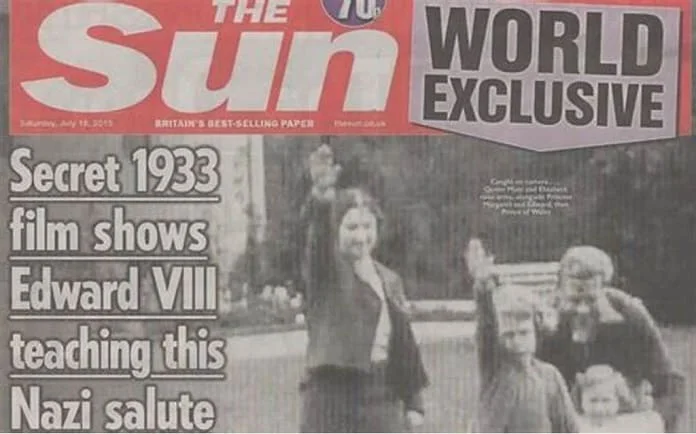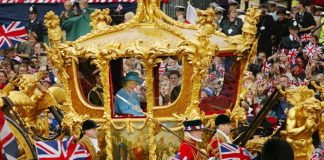Queen Elizabeth II, the longest reigning monarch of the UK and 14 other countries, including Australia, is dead. While the media says she was “dedicated to a life of duty”, her real job was to serve her family fortune, her class and their system.
Throughout her 70-year reign, the royal family has buttressed reactionary ideas—that some are born to rule and others to be ruled, that merit is of no importance and that inheritance is everything, and that the family unit is imperfect but central to society.
The idea that the royal family is “above politics” has been used to unify people around the interests of our rulers. Today, union leaders have called off strikes in Britain out of “respect”.
The more people revere their supposed betters, the less likely they are to take action against the unfair and unequal society they live in.
Nazi sympathiser
Born on 21 April 1926, there seemed little chance that Elizabeth would be Queen as she was third in line behind her uncle, King Edward VIII.
But Edward was a Nazi sympathiser, as was the woman he went on to marry, Wallis Simpson. Later, footage came to light of the young future Queen and family members being schooled in Nazi salutes.
Edward’s support for Hitler put him at odds with the overall interests of the British ruling class and their empire and he was forced to abdicate. The throne went Elizabeth’s father, George.
While she was on a trip to Kenya in 1952, King George VI died and Elizabeth became Queen.
Throughout her reign she was to be used as a voice for colonial and imperialist policy.
The year she visited Kenya, British troops were brought in to crush the Mau Mau rebellion, instituting a reign of terror followed that led to the brutal murder and torture of tens of thousands of Africans fighting for their independence.
After Kenya finally won its independence, the Queen wrote to President Mzee Jomo Kenyatta in 1963. She said, “I pray that with God’s guidance, Kenya may prosper and that her people may enjoy peace and contentment in full measure.” But it was another 50 years before Britain formally apologised for its atrocities.
Family of nations
Britain’s once vast empire was crumbling as the Queen ascended to the throne. Former colonial states were fighting and winning independence. To cling to their influence, the British ruling class re-badged the empire as the Commonwealth, a “family of nations”, with the Queen at its head.
The Commonwealth became useful as Britain suffered a labour shortage, with mass migration from south Asia, the Caribbean and Africa to fill its most lowly jobs.
It was also an attempt to erase the brutal legacy of empire and to try to create a false sense of unity between former colonies, the monarchy and the “motherland”.
The young Queen played an important role stabilising society in Britain, too. In 1953, only eight years had passed since the end of World War Two. Britain was bankrupt and in debt to the US. Major cities were still in ruins and many food items were still rationed.
With Britain in the grip of austerity, the ruling class thought the glamour of a coronation was an excellent opportunity to ramp up nationalist feeling and create a false sense of shared unity.
That unity did not extend to the fabulous wealth acquired by the royals over the years. Royal weddings and palaces have cost ordinary people dear.
Prince Charles and Diana’s wedding alone cost the taxpayer over $160 million in today’s money. In 2021-22, the Palace budget was $180 million and the Queen’s budget was a little more.
As growing scandals tarnished the royal image, the Queen tried to recast the royal family as just like ordinary people.
But it’s a family that owns 20 properties, ranging from the 1000-room Windsor Castle to the more modest 20-room Kensington Palace.
Until the late 1960s, “coloured immigrants or foreigners” were barred from taking up clerical jobs in royal households. To this day, Buckingham Palace is allowed to ignore race and sex discrimination laws.
That is real gold on those horse-drawn carriages and the royal crowns are encrusted with the real blood diamonds and rubies of empire.
The UK government is Her Majesty’s Government, the monarch appoints the prime minister and the armed forces swear allegiance to the monarch, not to the government or the people.
Revolution
In the English revolution of 1642-1649, early capitalist interests centred on parliament and led by Oliver Cromwell took power from King Charles I, who was beheaded.
After Cromwell’s death, parliament felt confident in its rule but wanted to restore stability at the top and deference among the lower classes. The constitutional monarchy which emerged was the compromise that paved the way for capitalism.
Monarchy was now re-fashioned by capitalism to serve its interests and the popularity of the royal family was mobilised to legitimise Britain and Australia’s class structure.
Its height was Queen Victoria providing a bulwark of reaction against radical change, while enabling imperialist expansion and capitalist robbery. Victoria was the Queen of Empire, Elizabeth was the Queen of Britain’s imperial decline.
The decline is more than symbolic. When she began her reign, Britain had more than 70 territories overseas. Today, there are 15 countries known as commonwealth realms. The Queen lost Barbados as recently as last year.
Australian sycophants
The mountains of obsequious drivel published in the mainstream Australian media about this super-rich, pampered person of limited talent reveals the nature of Australian capitalism.
The dispossession of Indigenous people that underpinned Australia’s origins as a colonial settler-state happened in the name of the King. More than 230 years since invasion, Charles is the new King of Australia.
While Labor talks about a referendum on the republic in its second term, Albanese is flying to London to take part in the royal funeral and associated ceremonies. It is a sign of loyalty to the system.
The non-Labor side of politics has always been associated with British royalty and traditions such as knighthoods.
Prime Minister Robert Menzies became Sir Robert Menzies in 1963, after telling the Queen in Canberra: “I did but see her passing by. And yet I love her till the day I die.”
The Liberal Premier of NSW from 1965-75, Robin Askin, was knighted in 1972. Askin got his mate, the owner of TNT, Peter Abeles, a knighthood the same day.
But the more far-sighted sections of the ruling class have begun to realise that Australian nationalism has to be revamped to incorporate the many new migrants who had no loyalty to a British crown.
By the early 1980s about one million immigrants had chosen not to become Australian citizens given they had to swear an oath of allegiance to the Queen.
So while our rulers love the glamour and pomp of royalty, many are open to a future republic.
The Queen will be missed by her class of rulers, powerful and wealthy.
But for workers, she was not our Queen and Charles is not our King. We have nothing to gain by revering a family that exists to celebrate inequality.
Our motto should be, roll on the red republic.
By Tom Orsag




